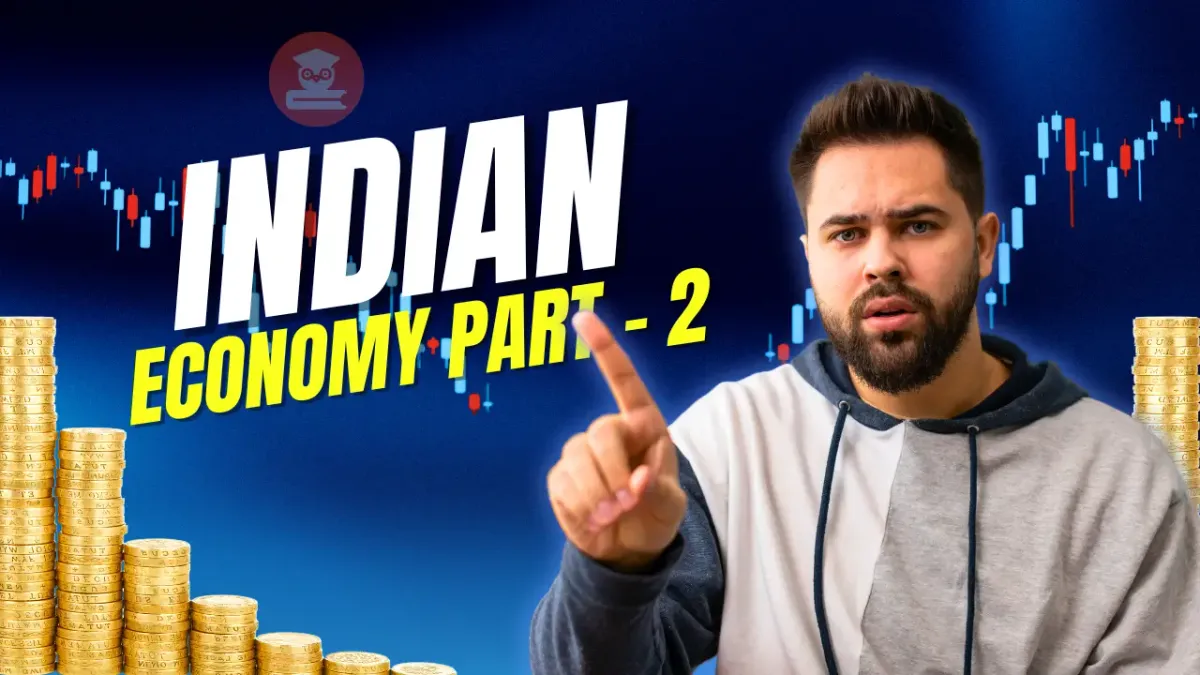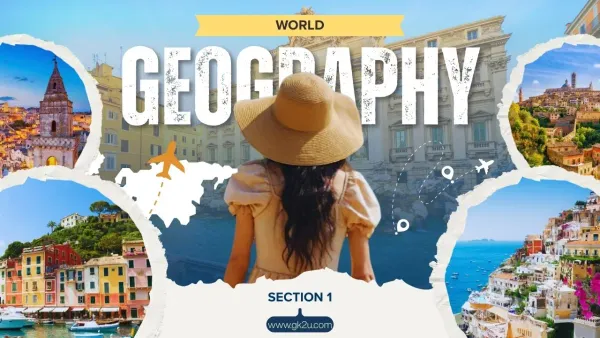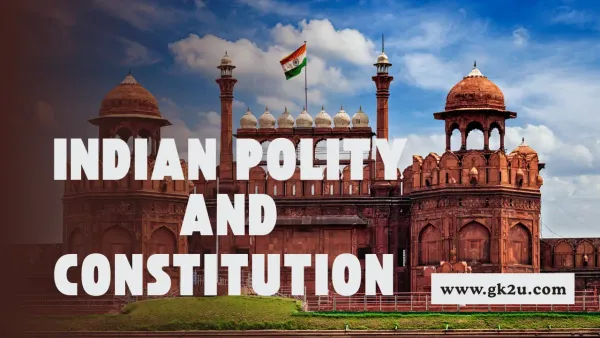Indian Economy General Knowledge for UPSC, APSC, SSC & Other Govt Exams – Part 2

The Indian Economy General Knowledge section is an essential part of every competitive exam in India, covering key facts, concepts, and developments related to India’s economic system. It provides a comprehensive understanding of how the Indian economy functions—from its historical evolution to its present structure and future goals. This section focuses on major topics such as Economic Planning, GDP, Inflation, Banking, Fiscal Policy, Monetary Policy, Agriculture, Industry, Budget, and Government Schemes.
India’s economy is one of the fastest-growing in the world, driven by sectors like services, manufacturing, and technology. Understanding the basics of economic reforms such as LPG (Liberalization, Privatization, and Globalization), and institutions like the RBI, SEBI, NABARD, and NITI Aayog, is crucial for exams like UPSC, APSC, SSC, Banking, Railways, and State PSCs.
This GK section not only strengthens your conceptual clarity but also helps you stay updated with current economic affairs like Union Budget announcements, economic surveys, and major government initiatives. Aspirants can access MCQs, notes, PDFs, and previous year questions to improve their preparation and accuracy in the Indian Economy section.
Whether you are a beginner or an advanced learner, this section provides well-organized study materials to help you master important topics and boost your confidence. Regular revision and practice of these economy-based GK questions can significantly improve your performance in any competitive examination.
1. Which of the following is an example of passive investment instrument?
(A) Mutual Funds
(B) Gold ETFs
(C) Stocks
(D) Preference shares
Correct Answer: (B) Gold ETFs
Answer Explanation:
Gold ETFs are passive investment instruments that are based on price movements and investments in physical gold.
2. Which among the following Ministries of India publishes the Employment News?
(A) Ministry of Labour & Employment
(B) Ministry of Communication
(C) Ministry of Information & Broadcasting
(D) Ministry of Education
Correct Answer: (C) Ministry of Information & Broadcasting
3. In which year, “20 Point Programme” was initiated for the first time in India?
(A) 1972
(B) 1975
(C) 1976
(D) 1978
Correct Answer: (B) 1975
Answer Explanation:
The Twenty Point Programme was initially launched by Prime Minister Indira Gandhi in 1975 and was subsequently restructured in 1982 and again on 1986. With the introduction of new policies and programmes it has been finally restructured in 2006 and it has been in operation at present. The Programmes and Schemes under TPP-2006 are in harmony with the priorities contained in the National Common Minimum Programme, the Millennium Development Goals of the United Nations and SAARC Social Charter. The restructured Programme called Twenty Point Programme – 2006 (TPP-2006), was approved by the Cabinet on 5th October 2006 and operated w.e.f 1.4.2007.
4. The rate at which RBI purchases or rediscounts bills of exchange of commercial banks is called?
(A) Repo rate
(B) Reverse repo rate
(C) Bank rate
(D) Base rate
Correct Answer: (C) Bank rate
Answer Explanation:
Bank Rate refers to the official interest rate at which RBI will provide loans to the banking system which includes commercial / cooperative banks, development banks etc. Such loans are given out either by direct lending or by rediscounting (buying back) the bills of commercial banks and treasury bills. Thus, bank rate is also known as discount rate. Bank rate is used as a signal by the RBI to the commercial banks on RBI’s thinking of what the interest rates should be. Bank Rate and Repo Rate seem to be similar terms because in both of them RBI lends to the banks. However, Repo Rate is a short-term measure and it refers to short-term loans and used for controlling the amount of money in the market. On the other hand, Bank Rate is a long-term measure and is governed by the long-term monetary policies of the RBI. In broader term, bank rate is the rate of interest which a central bank charges on the loans and advances that it extends to commercial banks and other financial intermediaries. RBI uses this tool to control the money supply.
5. Universalization of Secondary Education was an aim of which among the following five year plans?
(A) 9th
(B) 10th
(C) 11th
(D) 12th
Correct Answer: (C) 11th
6. If the demand and supply of a commodity increase by an equal absolute amount, what will be the effect on market price?
(A) Increase
(B) Decrease
(C) Remain Stable
(D) First decrease then increase
Correct Answer: (C) Remain Stable
7. Which among the following is the main feature of Democratic planning?
(A) Inducement
(B) Government
(C) Direction
(D) Flexibility
Correct Answer: (D) Flexibility
8. Which among the following is related to land development?
(A) NABARD
(B) SEBI
(C) NCDC
(D) SARDB
Correct Answer: (D) SARDB
Answer Explanation:
SARDB-State Co-operative Agriculture and Rural Development Bank
9. As per the Lakdawala Formula, which among the following is accepted to estimate “urban poverty”?
(A) Consumer price Index for industrial labors
(B) Consumer price Index for Agriculture
(C) Wholesale Price index
(D) B & C
Correct Answer: (A) Consumer price Index for industrial labors
10. In which year NHB Residex was launched?
(A) 2004
(B) 2005
(C) 2006
(D) 2007
Correct Answer: (D) 2007
11. Which among the following schemes is for prevention of Trafficking and Rescue, Rehabilitation and reintegration of Victims of Trafficking and Commercial Sexual Exploitation?
(A) Swawlamban
(B) Ujjawala
(C) Sahayogini
(D) Swadhar
Correct Answer: (B) Ujjawala
12. Many a times we read about “Circuit Breakers” in share markets. They are temporary measures which halt the trading on which of the following occasion?
(A) On special days
(B) When a new share is traded for the first time
(C) When the prices of particular stock’s) rises or falls by a specified amount in specified time
(D) When trading of a particular stock(s) has rises beyond a specified volume
Correct Answer: (C) When the prices of particular stock’s) rises or falls by a specified amount in specified time
13. Minting of Government medals is done at the following places?
(A) Hoshangabad
(B) Nasik & Dewas
(C) Kolkata & NOIDA
(D) Mysore and Mumbai
Correct Answer: (C) Kolkata & NOIDA
14. Which among the following is the standard map projection for nautical purposes (suitable for showing sea routes)?
(A) Mercator projection
(B) Cassini projection
(C) Gnomonic projection
(D) Polyconic Projection
Correct Answer: (A) Mercator projection
15. In the abbreviation APEDA, what does P stand for ?
(A) Pisciculture
(B) Products
(C) Processed Food Products
(D) Promotion
Correct Answer: (C) Processed Food Products
Answer Explanation:
APEDA- Agricultural AND Processed Food Product Export Development Authority
16. In which of the five year plan in India, the concept of Financial Inclusion was included for the first time?
(A) 8th Five Year Plan
(B) 9th Five Year Plan
(C) 10th Five Year Plan
(D) 11th Five Year Plan
Correct Answer: (D) 11th Five Year Plan
17. In context with the flow of the rural credit , which among the following comes at the last ?
(A) Primary Agricultural Cooperative Societies
(B) District Central Cooperative Banks
(C) State Agricultural Co-op Banks
(D) NABARD
Correct Answer: (A) Primary Agricultural Cooperative Societies
18. In which year India launched Targeted Public Distribution System ?
(A) 1995
(B) 1996
(C) 1997
(D) 1998
Correct Answer: (C) 1997
Answer Explanation:
The Targeted Public Distribution System (TPDS) replaced the erstwhile PDS from June 1997. Under the new system a two tier subsidized pricing system was introduced to benefit the poor.
19. Which among the following does not come under ISOPOM scheme?
(A) Oil Seeds
(B) Pulses
(C) Oil Palm
(D) Rice
Correct Answer: (D) Rice
Answer Explanation:
The first programme on Oilseeds was launched in 1986 as Technology Mission on Oilseeds (TMO). The core idea was to increase the production and productivity of oilseeds to make the country self-reliant in this vital sector. Later Pulses, Oil Palm & Maize were brought in its ambit in the 1990s. The scheme was later restructured in 2004 as Integrated Scheme of OilSeeds, Pulses,Oilpalm and Maize (ISOPOM).
20. Countervailing duty is imposed on which of the following?
(A) imported goods
(B) exported goods
(C) imported good on which import subsidy is applicable
(D) exported goods on which export subsidy is applicable
Correct Answer: (A) imported goods
21. Which among the following is a common industry in Bhadravati (Karnataka) , Churk (Uttar Pradesh), Dalmianagar (Bihar), Gwalior (Madhya Pradesh), Okha (Gujarat), Sawai Madhopur (Rajasthan) & Surajpur (Punjab)?
(A) Automobiles
(B) Textiles
(C) Cement
(D) Steel
Correct Answer: (C) Cement
22. Which among the following helps to solve the balance of payments problem of member countries?
(A) World Bank
(B) International Development Fund
(C) Asian Development Bank
(D) World Economic Forum
Correct Answer: (B) International Development Fund
23. Countervailing duty is imposed on which of the following?
(A) imported goods
(B) exported goods
(C) imported good on which import subsidy is applicable
(D) exported goods on which export subsidy is applicable
Correct Answer: (A) imported goods
24. What will be the ultimate impact on the poor and landless farmers if all of a sudden, government decides to raise the Minimum Support Prices of rice & food grains inexorably or excessively?
(A) The poor farmers become rich
(B) The markets will crash
(C) The poor farmers become more poor
(D) This will encourage the exports of rice and food grains
Correct Answer: (C) The poor farmers become more poor
25. Over how many years periodic review of the “Miniratna” & “Navratna” status of public enterprises on the basis of their performance?
(A) every year
(B) 2 years
(C) 3 years
(D) 5 years
Correct Answer: (C) 3 years
26. Which of the following IT companies had to cease its India operations in 1970s in the wake of the FERA restrictions and which reestablished itself only after 1992 when Economic Liberalization in India took place?
(A) Oracle
(B) IBM
(C) IBS Software Services
(D) Dell
Correct Answer: (B) IBM
27. Which among the following sector contributes maximum to GDP in India?
(A) Primary sector
(B) Secondary Sector
(C) Tertiary sector
(D) Quaternary sector
Correct Answer: (C) Tertiary sector
28. In context with the employment programmes in India, which among the following was the first to mandate child-care facilities for women at work sites?
(A) Shahari Rojgar Yojna
(B) Swaran Jayanti gram Swarozgar Yojna
(C) National Rural Employment Guarantee Act
(D) Jawahar Rozgar Yojna
Correct Answer: (C) National Rural Employment Guarantee Act
29. In a progressive tax , the following statements holds true:
(A) Yield from Income tax increases as the national income increases.
(B) Yield from income tax decreases as the national income increases
(C) Yield from income tax does not alter as the national income increases
(D) Yield from income tax may increase or decrease as the national income increases
Correct Answer: (A) Yield from Income tax increases as the national income increases.
30. Bombay Plan was presented in which year?
(A) 1934
(B) 1940
(C) 1942
(D) 1944
Correct Answer: (D) 1944
31. Under which of the following Ministries of Government of India works the Forward Markets Commission?
(A) Ministry of Corporate Affairs
(B) Ministry of Finance
(C) Ministry of Heavy Industries and Public Enterprises
(D) Ministry of Consumer Affairs, Food and Public Distribution
Correct Answer: (D) Ministry of Consumer Affairs, Food and Public Distribution
32. Which among the following is the core theme of Mahila Samakhya programme?
(A) Health and wellness of women
(B) Financial Independence of Women
(C) Health and wellness adolescent girls
(D) Education and empowerment of women
Correct Answer: (D) Education and empowerment of women
33. Kaveri Gill study is related to which of the following programme of Government of India?
(A) National Solar Mission
(B) National Rural Health Mission
(C) Bharat Nirman
(D) JNNURM
Correct Answer: (B) National Rural Health Mission
34. In context with Banking, which among the following is a correct with regard to Merchandise Credit and Merchandise Debit?
(A) Merchandise credit relate to export of goods while merchandise debit represent import of goods
(B) Merchandise credit relate to import of goods while merchandise debit represent export of goods
(C) Merchandise credit relate to procurement of goods while merchandise debit represent sale of goods
(D) Merchandise credit relate to sale of goods while merchandise debit represent procurement of goods
Correct Answer: (A) Merchandise credit relate to export of goods while merchandise debit represent import of goods
35. Industrial Licensing was finally abolished in India in which of the following years?
(A) 1990
(B) 1991
(C) 1992
(D) 1995
Correct Answer: (B) 1991
36. Approximately what fraction of India’s trade by volume is moved by sea?
(A) 70%
(B) 80%
(C) 90%
(D) 95%
Correct Answer: (D) 95%
37. Which among the following decides the Oil Prices in India?
(A) Government of India
(B) Government of Respective States
(C) Ministry of Petroleum
(D) Oil Companies
Correct Answer: (D) Oil Companies
38. What is the Value Added Tax (VAT)?
(A) A single tax that replaces State Taxes like surcharge, turnover tax, etc.
(B) A simple, transparent, easy to pay tax imposed on consumers.
(C) A new initiative taken by the government to increase the tax burden of high income groups.
(D) A new tax to be imposed on the producers of capital goods.
Correct Answer: (A) A single tax that replaces State Taxes like surcharge, turnover tax, etc.
39. The Tobin tax, initially suggested by James Tobin was a tax on which among the following transactions?
(A) Property Transactions
(B) Currency Transactions
(C) Industrial transactions
(D) All of the above
Correct Answer: (B) Currency Transactions
40. The term “Golden Revolution” is most closely related to which of the following missions?
(A) National Solar Mission
(B) National Horticulture Mission
(C) National Mission on Clean Coal Technologies
(D) National Bamboo Mission
Correct Answer: (B) National Horticulture Mission
41. The General Anti Avoidance and Thin Capitalization Rules to combat illicit transfer of money and assets abroad through complex financial arrangements and instruments, have been incorporated as a part of which among the following?
(A) Foreign Exchange Management Act, 1999 (FEMA)
(B) Prevention of Money Laundering Act, 2002 (PMLA)
(C) Direct Taxes Code Bill
(D) Income tax Act 1961
Correct Answer: (C) Direct Taxes Code Bill
42. The common international poverty line is based on an income of around___?
(A) $1.00 per day at the 2004 purchasing power parity
(B) $1.25 per day at the 2005 purchasing power parity
(C) $1.25 per day at the 2007 purchasing power parity
(D) $1.25 per day at the 2008 purchasing power parity
Correct Answer: (B) $1.25 per day at the 2005 purchasing power parity
43. In which year, the restructured Twenty Point Programme (TPP) became effective?
(A) 2005
(B) 2006
(C) 2007
(D) 2008
Correct Answer: (C) 2007
44. National Food Grain Movement Plan is primarily related to which among the following?
(A) Development of new seed varieties of food grains
(B) Opening food grain seeds villages
(C) Modernization of the Public Distribution System
(D) All the above
Correct Answer: (C) Modernization of the Public Distribution System
45. The Direct Taxes Code is related to which among the following?
(A) Income Tax
(B) Sales tax
(C) Excise Duty
(D) Service tax
Correct Answer: (A) Income Tax
46. The National Mission for Saffron has been launched as a subscheme of which among the following programme?
(A) National Food Security Mission
(B) National Horticulture Mission
(C) Rashtriya Krishi Vikas Yojana
(D) National Cash Crop Programme
Correct Answer: (C) Rashtriya Krishi Vikas Yojana
47. Which among the following programme is NOT being implemented in India with assistance of World Bank?
(A) National Vector Borne Disease Control and Polio Eradication
(B) National Rural Livelihoods Project
(C) PMGSY Rural Roads Project
(D) Delhi Mumbai Industrial Corridor Project
Correct Answer: (A) National Vector Borne Disease Control and Polio Eradication
48. Why the Indirect taxes are termed regressive taxing mechanisms?
(A) They are charged at higher rates than direct taxes
(B) They are charged the same for all income groups
(C) They are not charged the same for all income groups
(D) None of the above is a correct reason
Correct Answer: (B) They are charged the same for all income groups
Answer Explanation:
The indirect taxes like VAT etc are paid by everyone if they buy any product irrespective of financial conditions. Direct taxing is considered the most progressive taxing mechanisms because they justify the income levels of the people
49. Currently, which among the following products is facing imports ban from China?
(A) Milk and Milk products
(B) Rice
(C) Telecom equipment
(D) Heavy electrical engineering equipment
Correct Answer: (A) Milk and Milk products
Answer Explanation:
Import of milk and milk products have been banned owing to presence of toxic melamine content in the milk which started in 2008 and is being extended. On a special note India doesn’t import any milk or milk products from china and it is banned as a preventive measure.
50. Which among the following closest instrument to Gold ETF?
(A) Debenture
(B) G-Sec security
(C) Mutual Fund
(D) Commercial Paper
Correct Answer: (C) Mutual Fund
Answer Explanation:
Gold ETFs (Paper Gold) are mutual fund schemes that invest in standard gold bullion (of 99.5% purity). The value of an ETF is based on price of gold. These are alternative to owning physical gold.





